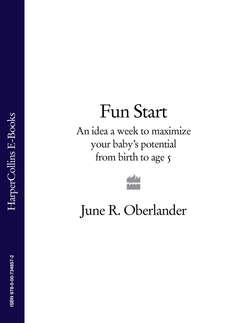Читать книгу Fun Start: An idea a week to maximize your baby’s potential from birth to age 5 - June Oberlander R. - Страница 5
ОглавлениеIntroduction
Suggestions to help implement the activities
This handbook was written primarily to bridge the gap between home and school. It contains weekly activities to correspond to the developmental patterns of each age group from birth to age five. There are 260 age appropriate activities that mainly use household items for materials. Explicit directions are written in layman’s language to ensure that people who use this book will understand how to implement each activity. A brief evaluation follows each experience so that the person will know what the desired outcome should be from each activity. Some activities may appear to be similar, but the intended concept for each activity is different. The title of the weekly activity and the evaluation of each should clarify any confusion.
There are parents who try to teach concepts or skills too early and consequently frustrate the child. They may present other concepts too late or not at all; therefore these parents have missed the optimum time to teach these concepts. Recent studies have confirmed that very early stimulation in young children gives them an enriched approach to learning, which produces better scholars in school; however, it must be done at the proper time.
As a retired kindergarten teacher with over 25 years of experience, I know that many gaps in learning can be prevented if children are subjected to brief, stimulating and challenging experiences at the appropriate age and developmental level. Basic concepts are more difficult for children to learn in school because they may have experienced lags in developmental learning at home.
How to use this handbook
Read through an entire weekly activity that is appropriate for the age of the child, remembering safety first.
Make certain that you understand the intended purpose of the activity.
Collect and assemble the necessary materials.
Decide how you plan to implement the activity.
Administer an activity when the child appears to be ready. It may not be at the same time each day.
Avoid too much structure but be consistent. Just doing an activity every now and then may prove to be ineffective.
Review the brief evaluation of each activity and evaluate the child’s progress.
Remember, a child begins at birth with an almost non-existent attention span that gradually expands to approximately 15 seconds during the first few months. Subsequently, the period of attention slowly increases. By age four, the child may still only be able to engage in an activity for a brief time. It depends on the child. With guidance and patience a child’s attention span can be increased.
Repeat the same weekly activity or repeat previously suggested activities throughout a given week. Repetition is very important.
Stop an activity when the child appears disinterested, frustrated or inattentive. Record this activity and try it again later. Feel free to alter the suggestions to meet the needs of the child.
Avoid introducing activities too soon. Pace the activities slowly and steadily.
Subsequent to doing an activity, refer to the measurable parameters checklist in the back of this book and have a pencil and paper ready to make notes of any observations, additions or comments regarding the activity and the child’s responses.
MEASURABLE PARAMETERS TO PROFILE CHILD DEVELOPMENT is a valuable checklist guide to help you determine the progress of a child from birth to age five through observations using a scoring system. It parallels skills addressed in the book and helps prevent the overlooking of skills that should be developed. This guide is divided into yearly segments—the first year contains two six-month checklist periods—and indicates whether a child’s progress is satisfactory or delayed and when a child is ready for school. Evaluation of a child should allow for different growth patterns and different personalities and needs.Young children learn through different play experiences and learn best when one concept (idea) at a time is presented. Children need to be guided with love, patience and praise and need to do activities that best suit their needs at their developmental level so they can succeed more often than fail.
